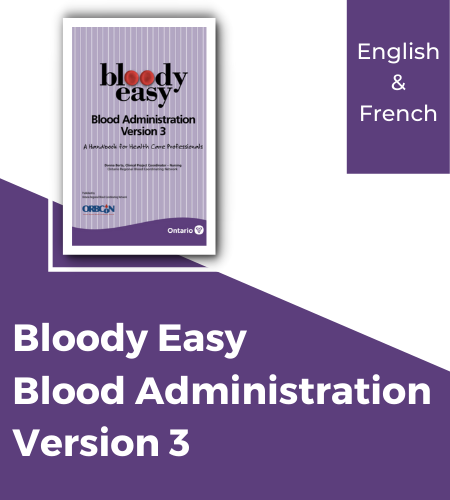Choosing Wisely for Perinatal Transfusion Medicine
Gwen Clarke MD FRCPC, Transfusion Medicine Physician, Canadian Blood Services
In 2020 members of the Canadian Obstetrical and Pediatric Transfusion Network (COPTN), worked with Choosing Wisely Canada to create a list of recommendations for immunohematology testing in perinatal women.
The first of the recommendations advises against routinely performing a group and screen prior to delivery. Very few women require transfusion during or following delivery, with studies showing a transfusion rate for vaginal and Caesarian section deliveries on the order of 0.5 – 1%. For those who do need very urgent transfusion, just like in any other life-threatening bleeding, use of O negative uncrossmatched blood is appropriate until pre transfusion testing has been completed. The safety of unmatched blood in this setting is enhanced when there is documentation that the antenatal antibody screening was negative.
Although a routine group and screen is not recommended, pre delivery testing is indicated if antenatal testing results are not available. If the mother is known to have a clinically significant alloantibody, is anemic or is at risk for bleeding then a group and screen prior to delivery is recommended. For example, women with placenta previa would benefit from testing prior to delivery. In addition, if fetal anemia is suspected, a maternal pre delivery group and screen may allow for rapid crossmatch of red cell units for the neonate post- delivery, if transfusion is required.
The second Choosing Wisely recommendation for perinatal testing refers to avoiding serological “weak D” testing in prenatal women.
Individuals with serologically weak or variably reactive RhD typing may have an RHD gene variant. These variants are often associated with an amino acid substitution of the RhD protein resulting in decreased expression of RhD on the cell. The frequency of such variants depends on ethnicity. Estimates in North America range from 0.2 – 1% of individuals (0.4% in a Canadian prenatal population) and include a large variety of RHD gene variations. Of these, weak D type 1, 2 and 3 are the most common.
Instead of serologically testing those with weak RhD reactions at the IAT phase (a weak D test), genotyping is the preferred evaluation for pregnant women with a weak RhD type. Genotyping will usually predict a specific weak or partial RhD type. Those with weak D type 1, 2 or 3 can be confidently treated as RhD positive, with no need for RhIG prophylaxis. Those with other variants should be treated as though RhD negative, as they may be at risk for alloimmunization to the RhD antigen. The need for RhIG prophylaxis for those with weak D type 4.0 is controversial. Most Canadian experts would recommend RhIG for this group of women.
The third recommendation suggests that noninvasive testing for prediction of the fetal antigen status should be performed if possible.
Alloimmunization impacts approximately 1% of pregnancies. When antibodies capable of contributing to Hemolytic Disease of the Fetus and Newborn (HDFN) are present, antibody titrations are regularly performed to evaluate the amount of antibody present. When titers rise to a lab determined “cut off” and/or are increasing, clinical monitoring for fetal anemia with doppler ultrasound and ongoing monitoring by a maternal fetal medicine physician are recommended.
For some alloimmunized women, however, this frequent monitoring is unnecessary: if the father is heterozygous for the implicated red cell antigen gene the fetus may or may not express the cognate antigen.
Non- invasive testing of maternal plasma, with amplification of fetal DNA from the maternal sample can predict the fetal red cell antigen status. If the fetus is antigen negative – there is no risk for HDFN despite the maternal alloantibody, and high- risk pregnancy monitoring is not required.
Non- invasive testing for prediction of fetal red cell antigen status is not currently available in Canada, however funding for such testing at reference labs is under consideration. In many provinces there is provision for sending blood samples from alloimmunized pregnant women to international reference labs for this testing. Indications for referral of samples to an international reference lab depend on the specific antibody present and may take into account the antibody titer and paternal phenotype.
When this assessment is feasible and predicts that the fetus is cognate antigen negative, the pregnancy requires only routine monitoring with no need for high-risk maternity care. This is both a cost-effective approach and one that improves the quality of care in pregnancy.
Transfusion Medicine Laboratories managing samples from alloimmunized prenatal patients are encouraged to work with their obstetrical and perinatal providers to determine whether reference testing for non- invasive determination of fetal blood group antigen status is feasible from their location.
The final Choosing Wisely Recommendation indicates that routine Direct antiglobulin testing (DAT) of neonatal cord samples should be avoided. The DAT does not predict which infants will develop hyperbilirubinemia nor those who require phototherapy. It may be positive in cases of maternal fetal ABO incompatibility that are not clinically significant. In short, it is not a good screening test with neither adequate specificity nor sensitivity as a predictor for significant jaundice.
The DAT should be performed on cord samples only when anemia or jaundice are identified as it can help pinpoint the cause (immune or non- immune). The DAT is also a valuable test in the setting of known maternal alloantibodies as it can determine whether the neonatal red cells express the corresponding antigen and the possibility of hemolysis and hyperbilirubinemia.
Conclusion:
The topics covered by these Choosing Wisely recommendations along with a number of other controversial topics in perinatal testing will form the basis of a Consensus Conference hosted by ORBCoN in May 2022. Following this conference consensus guidelines determined by 3 expert panels will be developed and will provide guidance for perinatal testing in Canada. Details, as they are released can be found here.
References for Recommendation 1
Stock O, Beckmann M. Why group & save? Blood transfusion at low-risk elective caesarean section. Aust N Z J Obstet Gynaecol 2014;54:279-82
Patterson JA, Roberts CL, Bowen JR, et al. Blood transfusion during pregnancy, birth, and the postnatal period. Obstet Gynecol 2014;123:126-33.
Einerson BD, Stehlikova Z, Nelson RE, et al. Transfusion Preparedness Strategies for Obstetric Hemorrhage: A Cost-Effectiveness Analysis. Obstet Gynecol 2017;130:1347-55.
Chua SC, Joung SJ, Aziz R. Incidence and risk factors predicting blood transfusion in caesarean section. Aust N Z J Obstet Gynecol 2009;49:490-3.
References for Recommendation 2
Sandler SG, Flegel WA, Westhoff CM, et al. It’s time to phase in RHD genotyping for patients with a serologic weak D phenotype. College of American Pathologists Transfusion Medicine Resource Committee Work Group. Transfusion 2015;55:680-9.
Flegel WA, et al. It’s time to phase out “serologic weak D phenotype and resolve D types with RHD genotyping including weak D type 4. Transfusion 2020; 60:855-9
Lieberman, Lani, MD; Flegel, Willy Albert, MD; Bodnar, Melanie, MD; Clarke, Gwen, MD; Hannon, Judith, MD. What constitutes the most cautious approach for a pregnant person with weak D type 4.0? CMAJ; Ottawa Vol. 193, Iss. 24, (Jun 14, 2021): E916
Wagner FF, Gassner C, Müller TH, et al. Molecular basis of weak D phenotypes. Blood 1999;93:385-393.
Garratty G. Do we need to be more concerned about weak D antigens? Transfusion 2005;45:1547-51.
References for Recommendation 3
De Haas M, van der Schoot E. Prenatal screening. ISBT Science Series 2013;8:6-10.
Scheffer et al. Noninvasive fetal blood group genotyping of rhesus D, c, E and of K in alloimmunised pregnant women. BJOG 2011; 118(11): 1340-8
Clausen FB. Integration of noninvasive prenatal prediction of fetal blood group into clinical prenatal care. Prenat Diagn 2014;34:409-15.
Non-invasive fetal genotyping for mothers with red cell antibodies and non-invasive fetal sex typing. https://ibgrl.blood.co.uk/services/molecular-diagnostics/fetal-genotyping-diagnostic/
References for Recommendation 4
Amy Keir, Minda Agpalo, Lani Lieberman, Jeannie Callum. How to use: the direct antiglobulin test in newborns. Archives of disease in childhood – Education & practice edition Aug 2015, 100 (4) 198-203; DOI: 10.1136/archdischild-2013-305553
American Academy of Pediatrics Subcommittee on Hyperbilirubinemia. Management of hyper bilirubinemia in the newborn infants 35 or more weeks of gestation. Pediatrics 2004;114: 297-316. Erratum in: Pediatrics 2004;114:1138.
Barrington KJ, Sankaran K, Canadian Paediatric Society Fetus and Newborn Committee. Guidelines for detection, management and prevention of hyperbilirubinemia in term and late preterm newborn infants. Paediatr Child Health 2007;12(Suppl B):1B-12B.
Queensland Health. Maternity and neonatal clinical guidelines. [Available from: https://www.health.qld.gov.au/qcg/publications#neonatal (accessed August 9, 2021).]


University of Toronto Transfusion Medicine Rounds
November 25th, 2021 @ 12:00 pm – 1:00 pm
Use of plasma and platelets prior to interventional radiology procedures (SIR guidelines) presented by Dr. Alexandre Menard